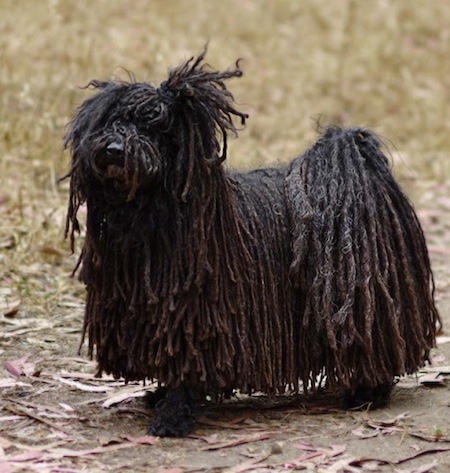
Naopleon the Hungarian Puli at 8 years old—"Naopleon is a Hungarian Puli with impeccable manners and a keen love of lying around. Particularly intelligent, he fetches pairs of shoes, his leash, and his dreadlock braiding kit on command before getting ready to go on walks."—Photo courtesy of David Hancock
POO-lee 
The Puli (Pulik. plural) is a medium-sized, compact, square-looking dog with a unique, corded coat. The body is fine-boned but fairly muscular. The domed head is in proportion to the body. The head from the side should be egg-shaped, while from the front it will give a rounded appearance. The tail should curl fairly tightly over the back. Eyes are almond-shaped and dark brown in color. The ears are medium-sized; pigment should be black. A full adult coat can reach to the ground. Some colors are not permitted in some countries, but in the U.K. black, any shade of gray, apricot (with or without a black mask) and the rarer white are all permissible.
The Puli is a lively, cheerful little dog that is very loyal. It is an excellent family pet and will adapt to most surroundings and circumstances. Its innate intelligence makes it easy to train. If the Puli senses its owners are not as strong minded as itself, it will become willful with a mind of its own, as it will believe it needs to make up its own rules of the home. Pulik do very well in obedience and agility as well as in the show ring. Though wary of strangers, they are never aggressive, but may well give a vocal warning if they feel their owner is being threatened. Pulik are not recommended for small children who may tease or be rough with them. Children need to be taught how to be pack leaders. It is important that you learn how to properly communicate with your dog.
Height: Males 16 - 17½ inches (41 - 46 cm) Females 14½ - 16 inches (36 - 41 cm)
(U.K. standard; slightly larger in the USA)
Weight: Males 25 - 35 pounds (11 - 16 kg) Females 20 - 30 pounds (9 - 14 kg)
The Puli is a very hardy breed. All reputable breeders will test their stock for hip dysplasia and will eye test, though there are no major health problems known within this breed.
The Puli will adapt to almost any circumstance, be it an apartment or a farm. This breed is suited to all climates. In the heat of Australia and Florida it does extremely well and, conversely in the extreme cold of areas like Denver in winter it also does likewise. It is fairly active indoors and will do okay without a yard.
Pulik need a daily walk or jog. While out on the walk the dog must be made to heel beside or behind the person holding the lead, as instinct tells a dog the leader leads the way, and that leader needs to be the human. These dogs are energetic and lively and are in their glory when allowed to romp and play, especially if their owner or a companion dog joins in the fun. Some of them are fond of water and can swim very well, but not all have this tendency and this should never be permitted unsupervised.
About 12 or more years
About 4 to 6 puppies
The corded coat begins to form around the age of 6 months, when the soft woolly undercoat intermingles with the harsher outer coat. The mats thus formed should be separated by hand very regularly at this stage. The clumps should be torn apart by hand from the tip to the skin. Each coat is individual but as a rough guide, these sections should not be made thinner than the width of a pencil. It is a relaxing and enjoyable process for dog and owner and if done regularly, takes little time. Keeping a fully corded Puli is very easy since they take little care apart from regular coat separation and, of course, bathing. Bathing is as easy as washing a sweater but drying does take some time. With a dryer, a fully corded Puli coat will take several hours and without a dryer it can take around 2 days to be fully dry. Eyes and ears should be cleaned regularly; nails kept clipped. The breed does not shed its coat. If you are allergic to dogs in general, you might try to see how you'd get along with a Puli since its coat is so different. A good breeder will let you visit several times by prior arrangement to see how their dogs affect you before you consider going ahead with a puppy.
An ancient breed, the Pulik crossed the plains into Hungary with the Magyars several thousand years ago where they were used as sheep dogs. Many shepherds seemed to prefer black dogs, but this was probably because they are easier to see among the flock. The Puli was the herding and droving dog, prized for its light, agile movement while the larger Hungarian breed, the Komondor, was more often used as a guarding dog for the flocks. At the time of the second world war, the breed had almost died out and its numbers were reduced to two figures. But a controlled breeding program assisted by dedicated breeders around the world ensured the survival of these unique little Hungarians. The Puli was recognized by the AKC in 1936.
Herding, AKC Herding
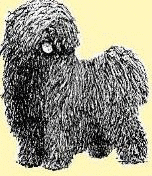
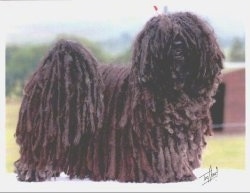
This is U.K. and USA Ch. Prydain Potpourri at Rockisland. Photo courtesy of Rockisland Puli
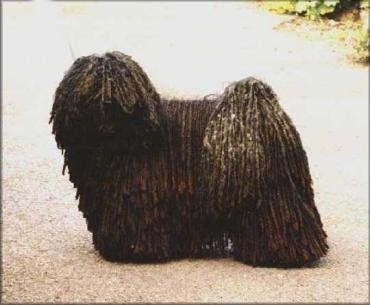
B.O.B. winner at Crufts in 1999 where he gained his 3rd. c.c. making him a champion on the day! Photo courtesy of Rockisland Puli. Many thanks to Elizabeth Williams for the information on this page.
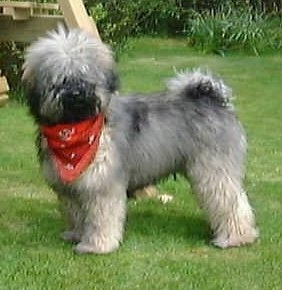
This is Merlin aka Rockisland Pied Piper, an adorable Puli puppy. Photo courtesy of Rockisland Puli
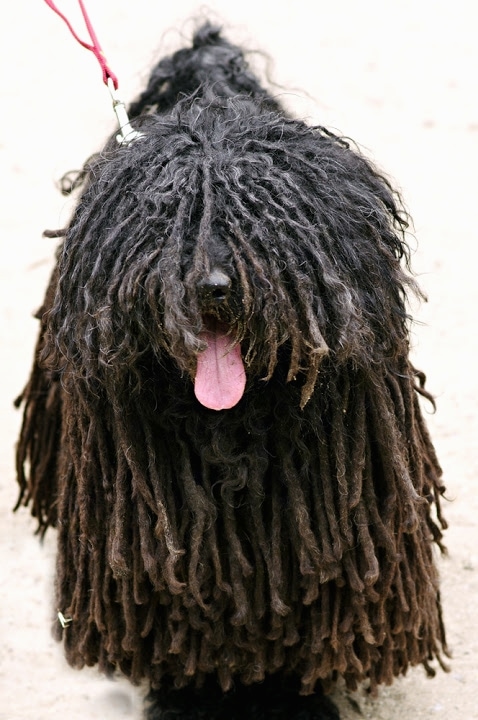
Naopleon the Hungarian Puli at 8 years old—Photo courtesy of David Hancock
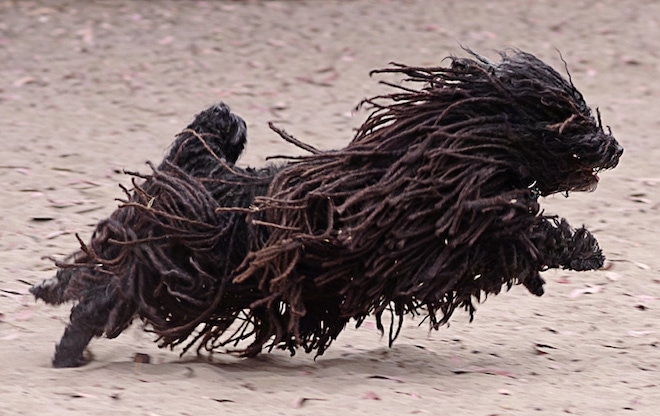
Naopleon the Hungarian Puli at 8 years old running top speed—Photo courtesy of David Hancock

Naopleon the Hungarian Puli at 8 years old playing with another dog—Photo courtesy of David Hancock
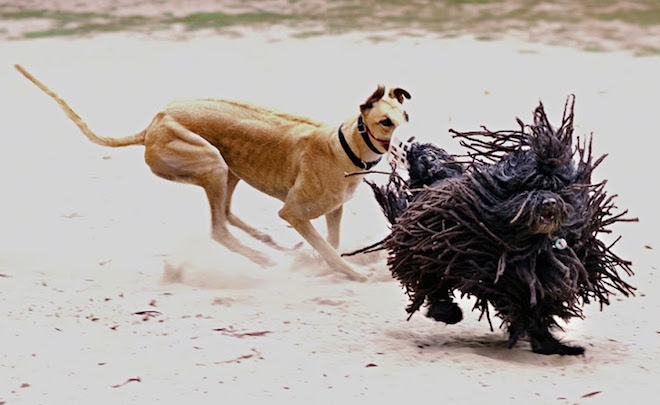
Naopleon the Hungarian Puli at 8 years old playing with another dog—Photo courtesy of David Hancock
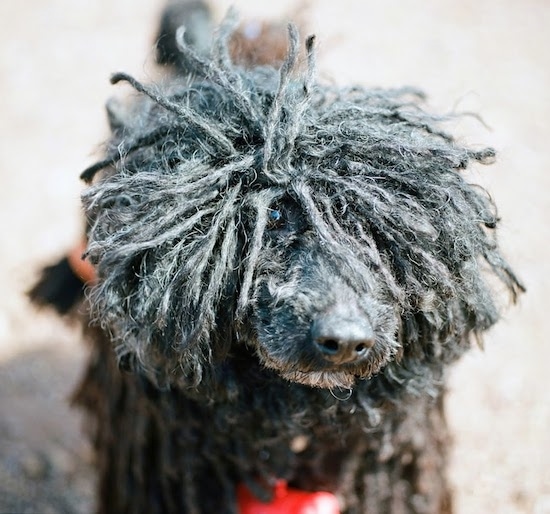
Naopleon the Hungarian Puli—Photo courtesy of David Hancock